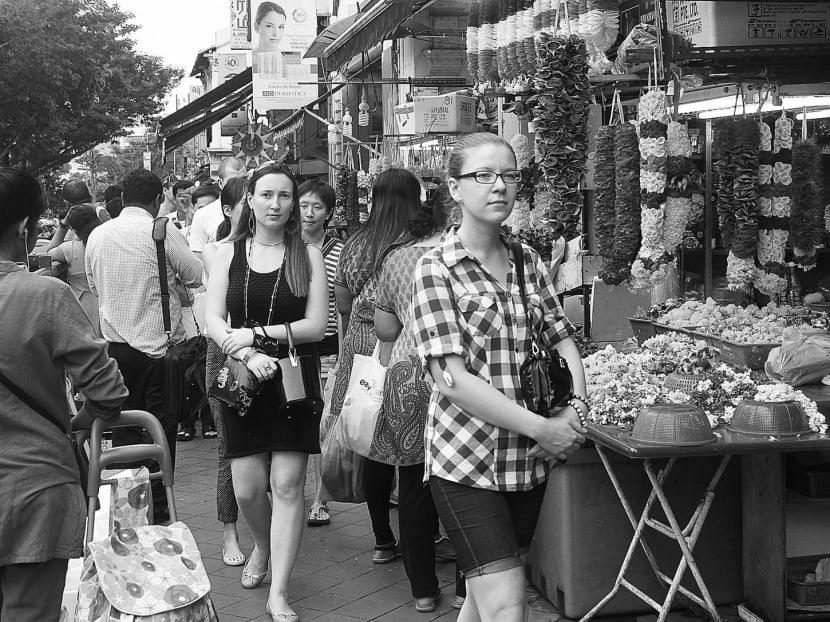Preserve the city’s character on the footways
A government crackdown to clear tables and chairs on the footways in Circular Road may sound like a small issue, yet it strikes at the heart of heritage here.

While having merchandise or tables on the footway may cause inconvenience to some pedestrians, many would argue that it adds character and is not dangerous. TODAY file photo
A government crackdown to clear tables and chairs on the footways in Circular Road may sound like a small issue, yet it strikes at the heart of heritage here.
In a notice to shop owners recently, the Land Transport Authority (LTA) said it spotted tables that would force pedestrians to walk on Circular Road itself. At least four businesses received warning letters from the LTA for obstructing pedestrians and road users, which the agency said subjects them to danger and inconvenience.
Section 32A of the Street Works Act clearly does allow LTA to take this action. It states that no person shall “deposit or cause or allow any article or thing to be deposited on any public street, five-footway or private footway”.
However, the LTA does not seem to be enforcing the same rule at most shops and construction sites in other places across the island.
In the Central Business District, for example, construction companies have obstructed, rerouted or even closed walkways along Cecil Street, Robinson Road and Shenton Way.
Walk along Serangoon Road or Geylang Road or other streets across the island and you will see shops or restaurants doing exactly the same thing as the restaurants on Circular Road. Tables, chairs, clothes, luggage and more line the footways, forcing pedestrians to squeeze past or venture out onto roads.
The stores have been doing the same thing for years and are not being forced to stop.
When Section 32A was introduced in August 2003, the LTA wrote to contractors and developers and specifically asked them to comply. Despite this, there has apparently been only sporadic enforcement action.
In 2011, for example, the LTA served 31 notices to coffee shop operators in Geylang for not removing chairs and tables that obstructed footways.
Indeed, the authorities seem to have accepted usage of most footways for a multitude of purposes for many years.
If LTA officers walked a few blocks over to Little India from their headquarters on Hampshire Road, they would find everything from spices and saris to tables and tomatoes blocking parts of the footways.
If enforcement of the rule is going to start, it would seem fair to apply it equally everywhere — all the time.
It hardly seems equitable to warn some shops or restaurant owners such as the case in Circular Road, where there have been few if any injuries from obstructed footpaths that they need to comply with the Act, while ignoring the same issues just a few blocks away.
And safety may be better served by focusing on Section 28 of the Road Traffic Act, which prohibits all vehicles except perambulators from being parked or ridden on footways. Motorcycles and scooters seem far more dangerous on footways than tables and chairs.
A PIECE OF SINGAPORE
The fundamental issue, however, is not just about fairness. It is also about the character of our city.
Footways date back to the Jackson Town Plan of 1822, which said houses should have a uniform type of front, a verandah of a certain depth, open at all times as a continuous and covered passage. Shop owners have displayed their wares on footways for decades and restaurants had tables on the footways years before the trendy concept of “al fresco” even made its way into the local lexicon.
While having merchandise or tables on the footway may cause inconvenience to some pedestrians, many would argue that it adds character and creates little or no danger.
Take them away and neighbourhoods will lose some of their vibe. Telling restaurants and shops to remove the tables and wares that people have been used to seeing all their life would take away yet another little piece of what it actually means to call Singapore home.
A solution, then, may be a change in the Act itself. The wording of the Act does not allow anything at all to be placed on a footway. If the law is to be enforced consistently, everything everywhere would need to go.
Policymakers could consider modifying the Act to allow at least some degree of flexibility.
Items could be allowed, for example, as long as pedestrians have a defined amount of space to pass by.
At the same time, enforcement should also be applied consistently or waived all across the island, rather than targeting one area that seems very similar to many others.
ABOUT THE AUTHOR:
Richard Hartung is a financial services consultant who has lived in Singapore since 1992.






